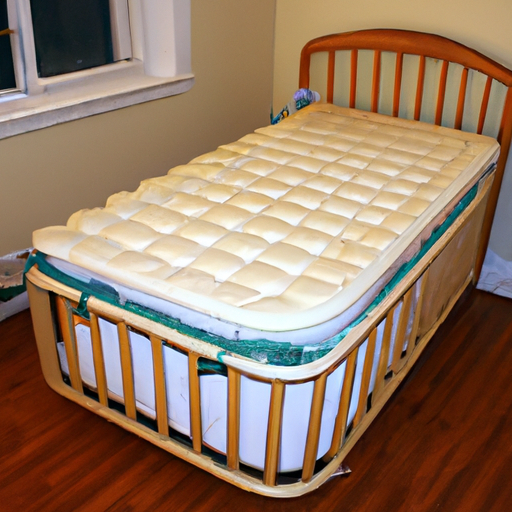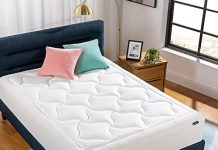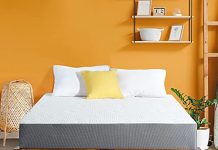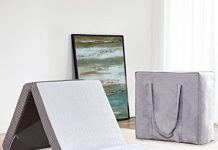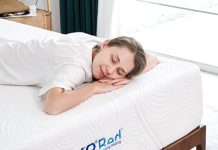Concerned about the safety of your baby’s sleeping environment? In the quest for finding the perfect mattress for your little one, you might have wondered about the safety of roll-up mattresses. With their convenient packaging and easy transportation, these mattresses may seem tempting. However, when it comes to the well-being of our precious infants, it’s vital to ensure a safe sleeping environment. So, let’s explore whether roll-up mattresses are indeed safe for our little bundles of joy.
Review contents
About Roll Up Mattresses
Roll up mattresses are a convenient and space-saving option for many households, including those with infants. These mattresses are typically made of foam and can be easily compressed and rolled up for transportation or storage. They offer a lightweight and portable alternative to traditional crib mattresses, making them ideal for families on the go or those with limited space.
Definition
Roll up mattresses, also known as compressed mattresses or bed-in-a-box mattresses, are designed to be easily rolled up and compressed for shipping and storage. They are made from various materials, including foam, and are typically sold in a compact box or bag. Once unpacked and unrolled, they expand and regain their original shape.
Benefits
There are several benefits to using roll up mattresses for infants. Firstly, their portability makes them ideal for families who frequently travel or live in smaller spaces, such as apartments or shared living spaces. They are lightweight, making them easy to transport, and can be stored away when not in use.
In addition to their portability, roll up mattresses often provide a comfortable and supportive sleeping surface for infants. Many models are made with high-quality foam that contours to the shape of the baby’s body, providing adequate support and reducing the risk of pressure points. Foam mattresses are also known for their ability to isolate movement, which can be beneficial when sharing a room with a restless sleeper.
Safety Concerns
While roll up mattresses can be a convenient choice for families, it is important to consider the potential safety concerns associated with their use, especially when it comes to infants.
Suffocation Hazard
One of the primary concerns with roll up mattresses is the risk of suffocation. Infants have limited mobility and may not have the strength or coordination to move themselves if their face becomes pressed against a soft or suffocating surface. It is crucial to ensure that the mattress is firm and provides ample support to minimize the risk of suffocation.
Firmness and Stability
Another safety concern is the firmness and stability of the mattress. It is recommended to choose a roll up mattress that is firm and provides a stable sleeping surface. This helps to prevent the baby’s face from sinking into the mattress, reducing the risk of suffocation. A mattress that is too soft or unstable may pose a safety hazard, especially for young infants who are not able to reposition themselves easily.
Chemical Exposure
Some roll up mattresses may contain chemicals, such as flame retardants or volatile organic compounds (VOCs), which can potentially be harmful to infants. When purchasing a roll up mattress, it is important to choose one that is certified to be free of harmful substances and meets safety standards. Look for certifications such as CertiPUR-US or GREENGUARD to ensure that the mattress meets rigorous standards for chemical emissions.
Allergenic Materials
It is also essential to consider the materials used in the construction of the roll up mattress to avoid potential allergens. Some infants may have allergies or sensitivities to certain materials, such as latex or synthetic fibers. Choosing a mattress made from hypoallergenic or natural materials can help reduce the risk of allergic reactions and provide a safer sleep environment for infants.
Quality and Durability
Lastly, it is important to consider the overall quality and durability of the roll up mattress. Check for reviews and ratings from other customers to gauge the mattress’s performance and durability over time. A high-quality mattress will be able to withstand regular use without sagging or losing its shape, ensuring that it remains a safe sleeping surface for the infant.
Factors to Consider
When choosing a roll up mattress for your infant, there are several important factors to consider to ensure their safety and comfort.
Material Composition
The material composition of the roll up mattress plays a significant role in its safety and comfort. Opt for mattresses made from high-quality foam that is firm and supportive. Avoid mattresses that contain potential allergens or harmful chemicals, such as synthetic latex or flame retardants.
Certifications and Standards
Look for certifications and standards that indicate the mattress has undergone rigorous testing and meets safety requirements. Certifications such as CertiPUR-US, GREENGUARD, or Oeko-Tex Standard 100 ensure that the mattress is free from harmful substances and emissions.
Breathability and Airflow
Good airflow and breathability are crucial for maintaining a safe sleeping environment for infants. Choose a roll up mattress that allows for proper ventilation to help regulate the baby’s body temperature and reduce the risk of overheating. Look for mattresses with open-cell foam or breathable covers to promote airflow.
Cover Properties
The cover of the roll up mattress is another important factor to consider. It should be removable, washable, and hypoallergenic. A waterproof cover can also be beneficial in protecting the mattress from spills or accidents and preventing the growth of mold or mildew.
Size and Fit
Ensure that the roll up mattress fits snugly and securely in the crib or bassinet without any gaps or spaces around the edges. A properly fitted mattress reduces the risk of entrapment or suffocation and provides a safe sleeping environment for the infant.
Safe Sleep Recommendations for Infants
While choosing a safe roll up mattress is essential, there are additional safe sleep recommendations for infants that should also be followed.
Back to Sleep Position
The American Academy of Pediatrics (AAP) recommends placing infants on their backs to sleep to reduce the risk of sudden infant death syndrome (SIDS). This sleep position has been shown to significantly decrease the likelihood of SIDS and is the safest sleep position for infants.
Firm Mattress
Infants should always sleep on a firm mattress to maintain a safe sleeping position. A soft or sagging mattress can increase the risk of suffocation, as the baby’s face may sink into the surface. Ensure that the roll up mattress meets the recommended firmness standards for infant sleep.
No Loose Bedding or Accessories
To reduce the risk of suffocation or entanglement, it is important to keep the baby’s sleep area free of loose bedding, blankets, pillows, or stuffed animals. These items can pose suffocation hazards if they cover the baby’s face or obstruct their breathing.
Temperature and Climate
Maintaining a comfortable and safe sleep environment also involves monitoring the room temperature and ensuring that the baby is not too hot or too cold. The room should be kept at a temperature between 68-72 degrees Fahrenheit (20-22 degrees Celsius) and dressed in appropriate sleep clothing to prevent overheating.
Room Sharing
The AAP recommends room sharing, where the baby sleeps in the same room as the parents but on a separate sleep surface, for at least the first six months to reduce the risk of SIDS. This practice allows for close monitoring and quicker response to the baby’s needs during sleep.
Research and Studies
Extensive research has been conducted to better understand the safety aspects of sleep surfaces for infants. These studies provide valuable insights into the risks and benefits associated with different mattress options.
Sleep-Related Deaths
According to the Centers for Disease Control and Prevention (CDC), sleep-related deaths, including SIDS and accidental suffocation, are a leading cause of infant mortality. Choosing a safe and appropriate sleep surface is crucial for reducing the risk of these tragic events.
Association Studies
Numerous association studies have focused on identifying the risk factors associated with sleep-related deaths. These studies have identified unsafe sleep environments, such as soft bedding, loose objects in the sleep area, and inappropriate sleep positions, as significant contributors to infant mortality.
Expert Opinions
Pediatricians and sleep safety organizations consistently emphasize the importance of safe sleep practices for infants. Experts recommend using a firm and flat sleep surface, avoiding soft bedding or accessories, and following safe sleep guidelines to reduce the risk of SIDS and suffocation.
Manufacturer Guidelines and Regulations
Manufacturers of infant products are required to adhere to specific safety standards and regulations to ensure their products are safe for use by infants.
Infant Product Safety Standards
There are established safety standards for cribs, bassinets, and play yards set by organizations such as the Consumer Product Safety Commission (CPSC) and the American Society for Testing and Materials (ASTM). These standards cover aspects such as mattress size, fit, and firmness, ensuring that products marketed for infants meet specific safety requirements.
Manufacturer Recommendations
In addition to meeting safety standards, manufacturers often provide specific guidelines and recommendations for the use of their roll up mattresses. It is essential to read and follow these instructions to ensure the mattress is used safely and appropriately.
Consumer Perspectives
Consumer perspectives play an important role in understanding the safety and usability of roll up mattresses for infants.
Reviews and Ratings
Reading reviews and ratings from other parents can provide valuable insights into the safety and performance of different roll up mattresses. Paying attention to reviews that specifically mention infant safety and satisfaction can help in making an informed decision.
Safety Precautions
Consumers should also take safety precautions when using roll up mattresses for infants. These precautions may include regular inspections for signs of wear or damage, ensuring proper fit and secure placement in the crib or bassinet, and following the manufacturer’s guidelines for weight limits and use.
Personal Experiences
Many parents have shared their personal experiences with using roll up mattresses for infants. While these experiences may vary, they can provide valuable firsthand insights into the safety, comfort, and quality of different mattress brands and models.
Alternatives to Roll Up Mattresses
If roll up mattresses do not meet your safety requirements or personal preferences, there are several alternative options available.
Traditional Crib Mattresses
Traditional crib mattresses are designed specifically for infants and meet safety standards. They come in various materials, such as foam or innerspring, and offer a firm and supportive sleeping surface for babies.
Foam or Memory Foam Mattresses
Foam or memory foam mattresses are another alternative worth considering. These mattresses can provide excellent support and comfort for infants, but it is crucial to choose a model that meets safety standards and is free from harmful chemicals.
Organic and Natural Mattresses
For parents who prefer more natural and organic materials, there are mattresses available that are made from organic cotton, wool, or natural latex. These mattresses are often hypoallergenic and meet stringent certifications for safety and environmental standards.
Waterproof Mattress Protectors
Using a waterproof mattress protector can be an excellent way to protect the mattress from spills, accidents, and potential allergens. These protectors create a barrier between the baby and the mattress, ensuring a clean and hygienic sleep surface.
Expert Recommendations
Pediatricians and sleep safety organizations offer valuable recommendations when it comes to choosing a safe sleep surface for infants.
Pediatricians’ Advice
Pediatricians recommend using a firm mattress that meets safety standards and fits properly in the crib or bassinet. They also stress the importance of following safe sleep practices, such as placing infants on their backs to sleep and avoiding loose bedding or accessories.
Sleep Safety Organizations
Sleep safety organizations, such as the American Academy of Pediatrics (AAP) and the National Institute for Child Health and Human Development (NICHD), provide guidelines and resources to promote safe sleep practices for infants. These organizations stress the importance of creating a safe sleep environment and following evidence-based recommendations.
Conclusion
When it comes to choosing a roll up mattress for an infant, it is crucial to prioritize safety, comfort, and suitability. Consider factors such as material composition, certifications, breathability, and size and fit to ensure a safe sleep environment for your baby. Follow safe sleep recommendations, manufacturer guidelines, and expert advice to further enhance the safety and well-being of your infant. Ultimately, the decision of whether roll up mattresses are safe for infants is a personal one that should take into account individual circumstances, preferences, and safety considerations.

